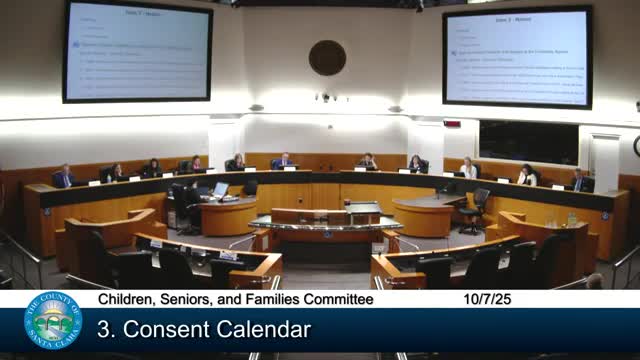Santa Clara Behavioral Health Services Reports On Schooling Supports And Challenges
October 07, 2025 | Santa Clara County, California
This article was created by AI summarizing key points discussed. AI makes mistakes, so for full details and context, please refer to the video of the full meeting. Please report any errors so we can fix them. Report an error »

The County of Santa Clara Children, Seniors, and Families Committee convened on October 7, 2025, to discuss critical updates on behavioral health services, particularly focusing on schooling services initiatives. The meeting featured a presentation by Catherine Esparis, the division director overseeing school-based services and early intervention programs, who provided an annual report highlighting the achievements and challenges faced in the past fiscal year.
Esparis reported that the schooling services program has successfully partnered with 27 school districts, serving over 7,400 students. The majority of these students were Latino or Latinx, with a significant portion in grades K through 5. The program has facilitated nearly 12,000 referrals and organized numerous family engagement events, which saw attendance from over 140,000 individuals. Despite these successes, there has been a noted decrease in attendance at in-person events, attributed to increased anxieties surrounding immigration enforcement in the community.
The presentation also detailed the multi-tiered system of supports, which provides varying levels of intervention based on student needs. Tier 1 offers universal strategies for all students, while Tier 2 and Tier 3 provide targeted support and intensive services, respectively. The report indicated a slight increase in the number of students served since the pandemic, alongside a 23% rise in referrals.
Looking ahead, the committee discussed the sustainability of these programs amid anticipated budget cuts. The behavioral health department is facing significant structural deficits, which may impact funding for non-mandated services. The committee expressed concern over the potential reduction of services, emphasizing the importance of maintaining support for students experiencing heightened anxiety and other challenges.
The meeting concluded with a commitment to continue exploring funding opportunities and improving service delivery, while also addressing the needs of students transitioning from closed wellness centers to ensure continuity of care. The committee acknowledged the importance of ongoing communication with school districts regarding budgetary changes and the potential impacts on services for vulnerable populations.
Esparis reported that the schooling services program has successfully partnered with 27 school districts, serving over 7,400 students. The majority of these students were Latino or Latinx, with a significant portion in grades K through 5. The program has facilitated nearly 12,000 referrals and organized numerous family engagement events, which saw attendance from over 140,000 individuals. Despite these successes, there has been a noted decrease in attendance at in-person events, attributed to increased anxieties surrounding immigration enforcement in the community.
The presentation also detailed the multi-tiered system of supports, which provides varying levels of intervention based on student needs. Tier 1 offers universal strategies for all students, while Tier 2 and Tier 3 provide targeted support and intensive services, respectively. The report indicated a slight increase in the number of students served since the pandemic, alongside a 23% rise in referrals.
Looking ahead, the committee discussed the sustainability of these programs amid anticipated budget cuts. The behavioral health department is facing significant structural deficits, which may impact funding for non-mandated services. The committee expressed concern over the potential reduction of services, emphasizing the importance of maintaining support for students experiencing heightened anxiety and other challenges.
The meeting concluded with a commitment to continue exploring funding opportunities and improving service delivery, while also addressing the needs of students transitioning from closed wellness centers to ensure continuity of care. The committee acknowledged the importance of ongoing communication with school districts regarding budgetary changes and the potential impacts on services for vulnerable populations.
View full meeting
This article is based on a recent meeting—watch the full video and explore the complete transcript for deeper insights into the discussion.
View full meeting
